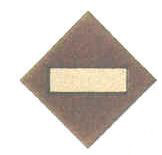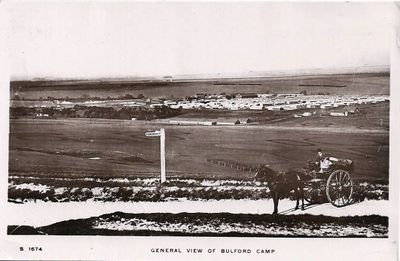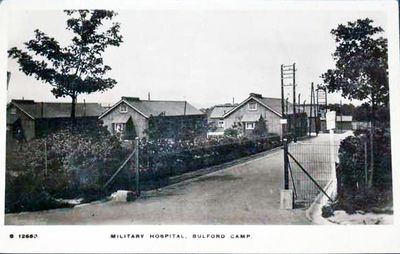Difference between revisions of "1st Australian Dermatological Hospital"
From Our Contribution
(→Soldier Patients by date admitted) |
|||
| Line 65: | Line 65: | ||
''1917'' | ''1917'' | ||
*[[Charles Blunt]] 10 - 20 Mar 1917 (total 69 days) | *[[Charles Blunt]] 10 - 20 Mar 1917 (total 69 days) | ||
| + | *[[Ernest Ball DCM]] 27 Mar - 15 May 1917 | ||
*[[William Bowman]] 31 Mar - 8 Aug 1917 (total 131 days) | *[[William Bowman]] 31 Mar - 8 Aug 1917 (total 131 days) | ||
*[[Frank Halliday]] 3 - 21 Sep 1917 (total 19 days) | *[[Frank Halliday]] 3 - 21 Sep 1917 (total 19 days) | ||
Revision as of 18:21, 18 May 2018
 1st ADH Colour Patch | |
 | |
 Bulford Military Hospital (1ADH) | |
| History | |
|---|---|
| Name | 1st Australian Dermatological Hospital |
| Where formed | Bulford |
| Date formed | November 1916 |
| Capacity | 1,500 patients |
| Locations | Codford, England |
General Information
Initially established in Abbassia, Egypt during 1915 it later relocated to Bulford in England.
The British Army had started to build training camps and garrisons on the Salisbury Plain in Wiltshire in the late 1890’s. Once such location was at Bulford which was greatly expanded during the war, becoming home to a number of the New Zealand Regiments. The site also included a hospital and this was passed to the jurisdiction of the Australians who established it as a specialist hospital for venereal diseases, becoming known as 1ADH. At its peak 1ADH was able to accommodate over 1,500 patients, some of which were under guard. Security however was not tight and going absent without leave relatively simple. Eventually criminal patients were treated at Lewes Prison in Sussex.
The Codford Anzac Cemetery contains the graves of 31 Australians and 66 New Zealanders.
Today Bulford Camp is one of the main garrisons for the British Army.
Staff
- Walter David Francis Kerridge 20 Jun - 27 Nov 1917
Soldier Patients by date admitted
1916
- Alexander Robinson 15 May - 12 Jun 1916 (total 39 days)
- Arthur Patrick Joyce 2 Aug - 11 Sep 1916 (total 41 days)
- Henry Ernest Howard 10 Aug - 30 Sep 1916 (total 52 days)
- Herbert Fuhrmann 1 Sep 1916 - 22 Jan 1917 (total 143 days)
- William Edward McKenna 11 Sep - 27 Oct 1916 (total 72 days)
- John Alexander Spilsbury 13 Sep - 29 Oct 1916 (total 46 days)
- John Alexander Adamson 13 Oct 1916 - 21 Apr 1917 (total 193 days)
- Thomas Joseph Sheehan 14 Nov - 18 Dec 1916 (total 158 days)
- Angus Dearden 9 Dec 1916 - 26 Feb 1917 (total 77 days)
1917
- Charles Blunt 10 - 20 Mar 1917 (total 69 days)
- Ernest Ball DCM 27 Mar - 15 May 1917
- William Bowman 31 Mar - 8 Aug 1917 (total 131 days)
- Frank Halliday 3 - 21 Sep 1917 (total 19 days)
- Beverley Loxton Bennett Oct/Nov 1917
- Patrick Joseph O'Brien 1 Oct 1917 - 26 Mar 1918 (total 177 days)
- John James Lynes Chester 25 Oct - 29 Dec 1917 (total 66 days)
- Richard Evans MM 1 Nov - 31 Dec 1917 total 41 days)
- Henry Ogilvie Allom (Jnr) Nov- Dec 1917 (total 38 days)
- George Weston Firns 15 Nov 1917 - 16 Feb 1918 (total 96 days)
- James Owen Horrocks16 Dec 1917 - 15 Mar 1918 (total 42 days only)
- Claude Francis Cooper 27 Dec 1917 - 9 Mar 1918 (total 50 days)
1918
- Hubert Maitland Armstrong MM 13 - 25 Apr 1918 and - 6 May 1918 (total 17 days)
- Albert George Bullock 12 Jul - 7 Oct 1918 (total 88 days)
- Clarence Victor Watson 23 - 28 Jul 1918
- Claude Francis Cooper 8 - 26 Aug 1918 (total 19 days)
- George Sydney Cook 20 Oct 1918 - 7 Mar 1919 (total 129 days)
- Clarence Victor Watson 26 Oct - 2 Nov 1918
- John Thomas Clements 27 Dec 1918 - 25 Feb 1919 (total of 148 days includes hospitals in France)
1919
- Charles Henry Partridge 11 Jan - 17 May 1919 (total 127 days)
- Lyndon Vivian Brady 16 Jan - 15 Feb 1919 (total 31 days)
- Eric Oswald Strang 14 - 17 Feb 1919 (total 51 days )
- Aubrey Turner 18 - 20 Feb 1919 (total 3 days)
- Leo Patrick Kane 3 - 22 Mar 1919 (total 30 days)
- Egbert Robert Trethowan Reeves 21 Mar - 11 Jul 1919 (total 113 days)
- Henry Ogilvie Allom (Jnr) Apr 1919 (total 3 days)
- George Charles Unwin May 1919
- John George (Jack) Ray 22 May - 12 Jul 1919 (total 56 days)